
Thursday April 6, 2023
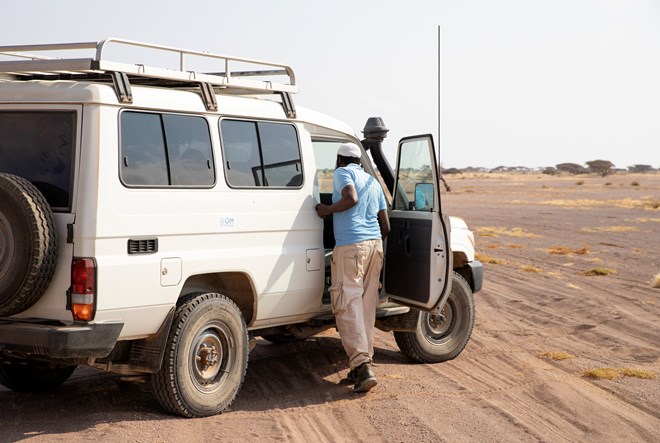 Doctor Youssouf Moussa (Medical Health Officer, Obock Migration Response Centre) outside the mobile patrol vehicle that he uses to conduct searches of the desert, looking for injured or vulnerable migrants in need of medical assistance. Photo: IOM 2023/Eva Sibanda
Doctor Youssouf Moussa (Medical Health Officer, Obock Migration Response Centre) outside the mobile patrol vehicle that he uses to conduct searches of the desert, looking for injured or vulnerable migrants in need of medical assistance. Photo: IOM 2023/Eva Sibanda
Djibouti, – March is officially labelled as winter (‘saison fraiche’) in Djibouti and yet temperatures can reach up to 29 degrees Celsius. It is difficult to imagine how people can make this journey, through the desert on foot in the summer months (June to July), but Dr Youssouf, who is responsible for running the International Organization for Migration's (IOM) mobile health patrols in the desert to provide life-saving assistance to migrants, says “They do.”
Dr Youssouf has been working in Obock for five years. He leads the IOM patrol teams who drive up to 100 kilometres through the desert looking for abandoned, stranded or otherwise vulnerable people in need of assistance. He explains that the priority for mobile patrols are vulnerable or sick migrants, usually among those returning from Yemen to Djibouti, hoping to get home to countries like Ethiopia. The other target group are migrants stranded in the desert trying to reach the Gulf nations, through Ras Siyyan, where they board boats to Yemen and move to the country’s borders.
“During the summer months, in June or July, temperatures reach up to 44 degrees Celsius,” Dr Youssouf explains.
The IOM mobile patrol units carry medical supplies, food, water and other essential items.
The patrols depart from the Migrant Response Centre in Obock, where migrants are provided with water, food, shelter, other essential items, medical care, as well as mental health and psychosocial support (MHPSS). The patrol heads towards the desert: the first stop where people are found gathering is in Fanteherou.
“There are much more women here now than I have previously observed,” Dr Youssouf says.
Fanteherou, located on the ‘Eastern Route’ between the city of Obock and the desert, is a small settlement hosting people displaced by drought and other reasons, and is where IOM’s mobile patrol units operate.
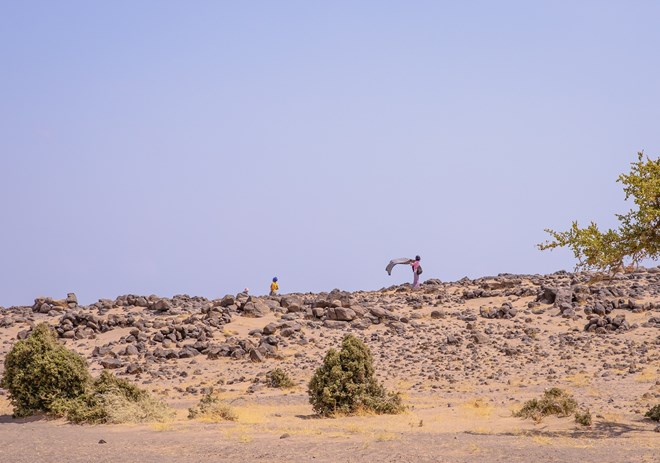
A migrant, part of a mixed group awaiting further instructions from their smuggler, airs out her scarf on a hill close to the ‘final destination’ in Djibouti, the coast at Ras Siyan, where they will attempt to board boats to Yemen across the Gulf of Aden. Photo: IOM 2023/Eva Sibanda
According to IOM data, the number of women and girls travelling along the Eastern Route – from the Horn of Africa (Ethiopia, Somalia, Djibouti) to Yemen – nearly doubled between 2021 and 2022, from 53,200 to 106,700. In Djibouti, the percentage of women and girls on the move rose from 13 per cent in 2021 to 22 per cent in 2022.
The migrants mostly come from Ethiopia. Dr Youssouf greets and strikes up a conversation with the migrants as he assesses any medical needs among the group.
Nasteho Mouktar, 18, originally from Djidjia, Ethiopia, shared that she wants to go to the Kingdom of Saudi Arabia to find work as a domestic worker and provide for her family.
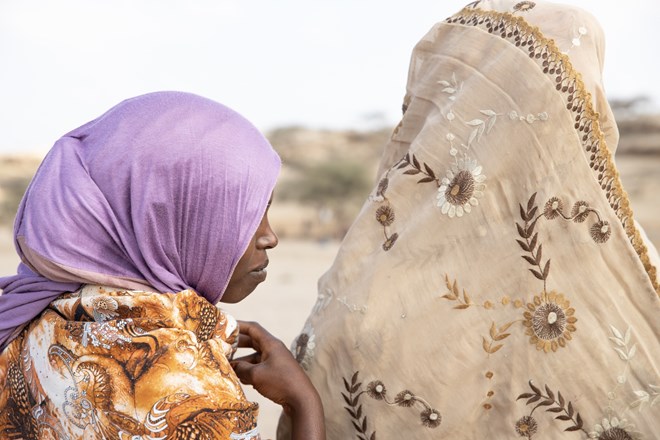 Young women migrating from Ethiopia with the hopes of a better life in the Gulf State. Photo: IOM 2023/Eva Sibanda
Young women migrating from Ethiopia with the hopes of a better life in the Gulf State. Photo: IOM 2023/Eva Sibanda

Nasteho (with an orange scarf) is embraced by a friend as she recounts her story to Dr Youssouf Moussa. Photo: IOM 2023/Eva Sibanda
Nasteho has been on this journey with her group of friends, over the last few weeks, having left her hometown with the help of smugglers.
In Fanteherou, these young women from Ethiopia have been waiting for the smuggler to return for five days, to hear about the next steps on their journey. Nasteho shared that the journey had not been what she anticipated, as the smugglers made them wait for days.
“They always tell us: tomorrow, tomorrow!”
Despite the difficulties she has had, she tells Dr Youssouf that she remains determined and convinced to continue her journey. The group of young women seek solace in each other and remain humorous despite the 80-kilometre desert-stretch journey that awaits them.
The Desert
Next stop on the mobile patrol is Garouwo, about 30 kilometres from Fanteherou. Dr Youssouf’s attention is caught by some items under a tree. We follow footprints in the sand up to the tree, where we see items of discarded clothing. Dr Youssouf explains that migrants often undress due to the heat and the burden of carrying clothing on their journey.
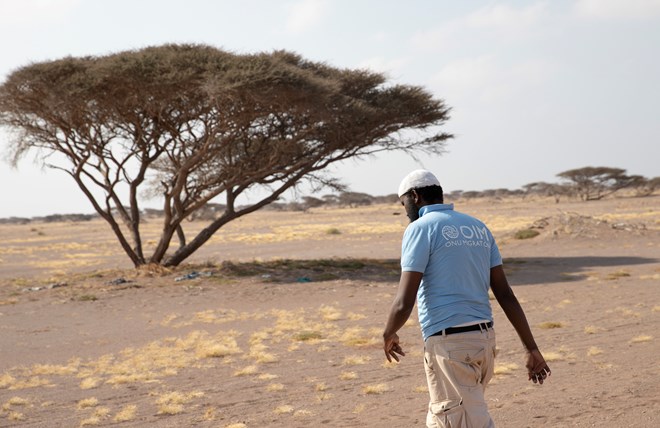
Dr Youssouf walking through the desert, investigating items of clothing, evidence of migrants’ presence. Photo: IOM 2023/Eva Sibanda
“The biggest danger for migrants is dehydration, which can happen especially when they lose their way,” explains Dr Youssouf, referring to several cases of bodies found in the desert.
The mobile patrols travel at night as well as during the day. IOM puts up signs and solar lights to guide migrants to follow the right direction. In the mobile patrol, Dr Youssouf is accompanied by a driver trained in first aid.
IOM has placed signs throughout the desert that lead migrants in the direction of water reservoirs and the city of Obock. There are four water reservoirs along the desert route, where migrants can fill their water bottles, bathe, and cook. These water points are solar lit at night and serve as guides for lost migrants in the vast desert. The mobile patrols also perform a routine check of the levels in the various water tanks.
As the unit continues towards the coast region, Dr Youssouf explained that, from 2020, the coast exit points that are most used are those the furthest away, such as Khor Angar. Migrants head further away, to avoid the areas most monitored by coast guards.
 Signs set up by IOM throughout the desert to guide lost migrants to water points. Photo: IOM 2023/Eva Sibanda
Signs set up by IOM throughout the desert to guide lost migrants to water points. Photo: IOM 2023/Eva Sibanda
Dr Youssouf works closely with Ahmed Ali, IOM Displacement Tracking Matrix Officer in Khor Angar locality, in the north of Obock. He tells Dr Youssouf that there is a large mixed group of people in the Rass Siyan area. That's where Dr Youssouf and his team then take off towards for the last stop before migrants prepare to use small boats to cross the Gulf of Aden into Yemen.
As Dr Youssouf leads the patrol team back to Obock he says: “Over the past five years of my work here, the needs keep growing and the situation remains desperate. I am committed to continuing providing health care to everyone I encounter on this route.”
IOM Djibouti operates a single patrol operating on two different routes according to a schedule. There is one patrol that departs to the North (from Obock to Moulhoulé); the second route traverses toward the South (from Obock to Lac Assal). Depending on the need, Dr Youssouf noted that they can undertake two outings on the two routes in the same day.
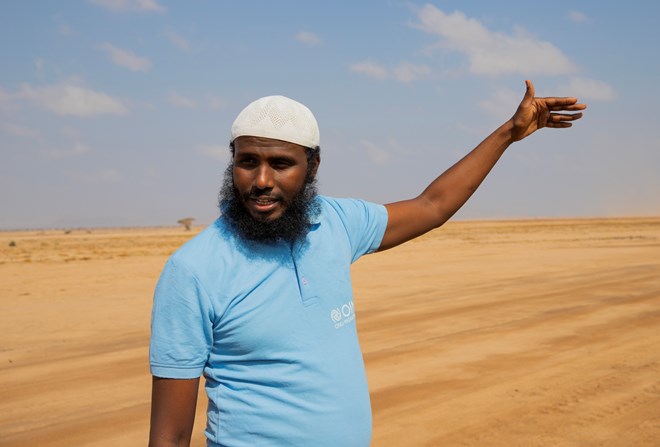
“The desert is extremely vast, finding migrants who are lost is truly complicated because of the size of this desert.” Photo: IOM 2023/Eva Sibanda
“Since the beginning of the patrol in June 2020, we have provided assistance to more than 18,000 migrants.” The average number of migrants per week depends on the flow of migrants, but the numbers range between 100 to 200 migrants encountered per week.
This response is aligned with the 2023 regional Migrant Response Plan (MRP) for the Horn of Africa and Yemen. The MRP aims to address the needs of migrants in vulnerable situations and host communities in countries along the Eastern migratory route, from the Horn of Africa to Yemen. The mobile patrols contribute to Strategic Objective 1 of the Migrant Response Plan, to provide life-saving assistance to vulnerable migrants and Objective 4 to build evidence, partnerships, and coordination to enhance the humanitarian response and migration management throughout the migration route.
The MRP is appealing for funding (USD 84 million) to assist communities of origin and host communities respond to the challenges of migrants in transit and trying to return home. The funds will help IOM and partners to strengthen the capacity of governments to provide humanitarian assistance and protection interventions, and improve the coordination of responses, enhance evidence base and strengthen migration management on the Eastern Route.
Written by Eva Sibanda, Communications Officer, IOM Regional Office for East and Horn of Africa